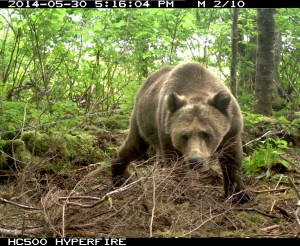Research Methods
We monitor and conserve wildlife and the ecosystems that support them, and are committed to ensuring that our research methods are the least invasive possible.
Remote Cameras
Monitoring day and night.
 Thanks to generous investments by our partners and donors, we currently deploy 42 remote cameras in our study area. These cameras offer an amazing window into bear behaviour and activity patterns at all times of day and night, without the animals ever having to come into contact with our researchers.
Thanks to generous investments by our partners and donors, we currently deploy 42 remote cameras in our study area. These cameras offer an amazing window into bear behaviour and activity patterns at all times of day and night, without the animals ever having to come into contact with our researchers.
Study Sites
All we need is a few hairs.
From May to September each year, we monitor bear populations throughout an area approximately 6,000 km2 (2300 miles2). Within this study area, we monitor 70 sampling locations. At each location we either build a snag station (a corral built out of barbed wire) or use a rub tree (an existing rub tree that we wrap with barbed wire). For the snag stations, we build a pile of sticks and moss in the middle of each corral and put non-reward (liquid) scent bait on the pile to attract bears to the area. By ‘non-reward’ we mean that the bears are attracted to the smell of the bait but there is no food reward when they come to the site. This way, the bears come into the corral, leave some hair when they step over the barbed wire, but do not get habituated to, or defend, the site. The hair left behind on the wire provides us with enough information to identify individual bears by their DNA, allowing us to track them over space and time. It also provides information about their stress levels from hormones in the hair, and also information about their diet and gender.
Local Knowledge
Honouring multiple ways of knowing.
While bear hair and remote cameras offer us valuable information and insight into research questions we are interested in answering, we appreciate that scientific understanding is not the only way of knowing. We see the value of spending time on the ground in the systems that we work in, but we have only done so for part of each year for a handful of years. On the other hand, our community partners, collaborators, and friends from Klemtu can guide and enrich the research through their intimate knowledge of local landscapes, weather systems, and wildlife populations. Traditional and Local Ecological Knowledge (TEK/LEK) are gained through lifetimes of living in a place, passed down over multiple generations. We value TEK/LEK and strive to acknowledge and include this knowledge system in our research program.

